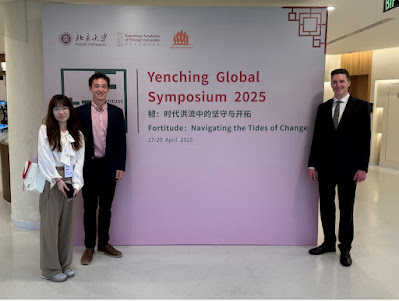In late November, twenty students from Washington, Bologna, and Nanjing participated on the SAIS Energy Tour of China study trip. The purpose of the trip was to allow students to study the energy transition currently underway in China and was conducted with the support of the China-US Exchange Foundation. The themes of the trip were energy governance, renewable technology innovation, commercialization of renewables and new energy storage, and consumption and end-use efficiency. The students visited three Chinese cities, Beijing, Shenzhen and Shanghai, and explored a different theme in each. Hopkins-Nanjing Center (HNC) Professor Roger Raufer and Johns Hopkins SAIS Professor Rui Wang led the group, which included eight students from the HNC, ten students from D.C., and two students from Bologna, Italy.
 |
| The whole group enjoying a blustery winter day at the Ming Tombs |
Our trip started in Beijing, the political center of China, and our meetings focused on energy governance. On the first day we met with the National Development and Reform Commission, the Energy Research Institute, the National Energy Administration, and the Ministry of Environmental Protection. We also enjoyed an informal lunch discussion with a representative from the Paulson Institute.
The following day, we flew to the sunny southern city of Shenzhen in Guangdong Province, China’s high-tech capital, to learn more about innovation in the renewables field and meet with the Shenzhen Energy Group, the Tsinghua-Berkeley-Shenzhen Institute, and BYD, which is a major manufacturer of electric vehicles.
 |
| Hard-hat-selfie at a waste-to-energy plant |
 |
| Gazing upon the diorama of the future at BYD |
The last city we visited was Shanghai, located in the Yangtze River Delta, which is China’s manufacturing heartland and a major center of renewables commercialization in its own right. In Shanghai, we visited the Trina Group, located just outside the city and one of the world’s largest manufacturers of solar panels (and a major innovator in new energy storage,) as well as a power plant owned by Guodian, one of the largest utilities in the country. We also visited Nicobar, a small nuclear analytics and consulting firm, and the Shanghai Institutes for International Studies. The last visit of our tour was to the Nanhui New City: a breathtakingly ambitious eco-town that the Chinese government has constructed from reclaimed land on China’s Pacific coast.
 |
| Getting ready to meet with the Ministry of Environmental Protection |
The SAIS Energy Tour study trip was an amazing experience. All of us learned a great deal about the changes and opportunities occurring within China’s energy sphere, whether we have lived in this country for many years, or were visiting for the very first time. We also saw some things that were already familiar to us from our studies. It was especially interesting to see some of the pollution control technologies we recently discussed in HNC Professor Raufer’s class “Air Pollution and its Control” being implemented in Chinese power plants, and those students who will take Professor Wang’s class in Washington on sustainable urban planning this spring in Washington will benefit greatly from having toured the Nanhui New City.
The main takeaway of the trip for most of us was that China is in the process of transitioning to an energy system based around renewables, distributed storage, and smart grids. They have already developed and commercialized some truly impressive technologies, and are making progress towards implementing a national level emissions-trading platform that will make China a global leader on climate change (as was evident in our visit to two carbon emissions exchanges, in Beijing and Shenzhen.) At the same time, our visit to the Guodian Changzhou coal-fired power plant underlined just how significant China’s coal industry still is, and how much further renewable energy technology will have to develop before it can replace such a facility.
 |
| Enjoying a well-earned boat cruise in Shanghai at the conclusion of a successful trip |
As China continues to develop at a breakneck pace, study tours like ours will be critically important for understanding the direction of clean energy transition both here and in the rest of the world. We all feel incredibly lucky to have participated in the SAIS Energy Tour.
Written by Gillian Zwicker, MAIS ‘18 and Kenneth Rosenkranz, MAIS ‘18







